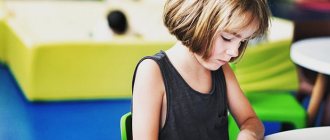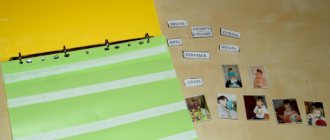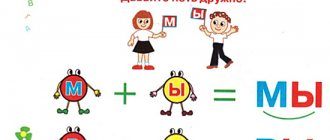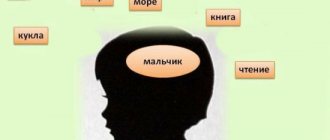Your psychologist. The work of a psychologist at school.
| Methodology for diagnostic neuropsychological examination of children |
| Visuospatial gnosis |
| Somato-spatial gnosis |
| Common memory |
| Auditory-speech memory |
| Visual-object memory |
| Attention |
| Speech and speech processes |
| Expressive speech |
| Impressive speech |
| Agraphia. Writing Study |
| Intellectual activity |
| DICTIONARY of medical terms found in the manual |
| All pages |
Page 3 of 15
3. METHOD OF DIAGNOSTIC NEUROPSYCHOLOGICAL EXAMINATION OF CHILDREN
3.1. Motor sphere In children with mental retardation (MDD) and other problems, age-related insufficiency in the development of motor skills and various types of movement : movements are poorly coordinated, are awkward and unclear, sometimes movements are inappropriate, there are many unnecessary unnecessary movements, the gait is poorly coordinated; speed and clarity are reduced, rhythm and smoothness are absent. An examination of the motor sphere begins with studying the violation or preservation of the general characteristics of the child’s movements . It should be noted : a) general mobility, b) stability and instability of gait, c) coordination of movements, d) speed, e) smoothness, f) switchability, g) rhythm, h) the ability to move to music. Then, object-household and object-play skills : a) the child’s spontaneous actions with objects (in play activities); b) voluntary actions with objects according to verbal instructions “take the cube”, “catch the ball”, “look out the window”; c) without verbal instructions for imitation. The arbitrary form of different types of praxis is then explored. Tests for performing subject actions and their number are offered taking into account the age of the child . All tests are performed by demonstration and imitation. Verbal instructions are given . If necessary, additional tests are used to either facilitate or complicate the test, which makes it possible to clarify the mechanism of the disorder and find the child’s zone of proximal development. All types of praxis are studied - dynamic, postural praxis, oral, spatial, constructive . Any objective action can be performed provided that appropriate impulses arrive from different parts of the brain in response to the task - take an object, raise or lower a hand, etc. Each part of the brain makes its own specific contribution to the organization of a full-fledged objective action. This functional system, consisting of various afferentations, is always aimed at completing a task. Damage to any part of the brain, or its underdevelopment, leads to disruption of the entire functional system and objective action is disrupted, but each time in a different way, and this depends on which part of the brain is affected. The latter can be found out by analyzing test execution errors. Postural praxis is aimed at studying the kinesthetic sensations involved in movements, which are provided by the parietal areas of the cerebral cortex. Dynamic praxis - the dynamic organization of actions, their sequence, and the ability to switch from one action (or element) to another are studied. This component of movement is provided by the posterior frontal cortex of the left hemisphere. The dynamic organization of movement is also ensured by the deep parts of the brain, which are responsible for the joint work of both hemispheres (corpus callosum, etc.). To study the state of these areas of the brain, a test for reciprocal coordination of movements . Spatial praxis - its study makes it possible to judge the safety (or violation) of the spatial and somatic-spatial organization of objective actions, their execution in space. This component of the motor act is ensured by the work of the parietal and parieto-occipital zones of the cerebral cortex and the joint activity of the spatial, auditory, and vestibular analyzers. In general, complex spatial actions are provided by the tertiary zone of the TPO - the temporo-parietal-occipital zone. Research into the preservation of this type of praxis is very important, because the preservation of this zone is necessary for the formation and implementation of a number of important HPFs. Constructive praxis is also aimed at studying the formation of spatial perception and optical-spatial actions (parieto-occipital areas of the brain).
| Tests | Material | Instructions | Analysis of symptoms (errors) |
| 1 | 2 | 3 | 4 |
| Praxis posture – hands | Test for the kinesthetic organization of object actions. Extend forward the 2nd and 5th fingers (goat), 2nd and 3rd (scissors). According to the verbal instructions - “extend the 2nd and 5th fingers”, etc. 2nd finger. Make a ring from the 1st and each subsequent finger | According to the example - “do as I do.” According to the verbal instructions “extend the 2nd and 5th fingers”, etc. | Primary errors - the 1st and 5th fingers are not differentiated, difficulties when trying to make a ring, searching for poses, fingering in search of the desired pose, deterioration in performing tests with eyes closed, etc. - indicate dysfunction of the kinesthetic analyzer, the parietal parts of the brain |
| Dynamic Praxis | Test for the dynamic organization of a motor act:
| Following the example: “Look at what I do and repeat.” According to the verbal instructions “Make a fist-rib-palm”, etc. Listen to me and do as I say: 1st finger, then 2nd finger. Now put it away; 1st finger - 5th, 1st - 2nd finger, 1st - 5th ... " | Primary errors:
|
| Graphic sample "fence" | Continue drawing the “fence” according to the model without lifting your hand | In a graphic test, one of the elements may be repeated inertly, there may be difficulties in switching from one element to another, and in perseveration. Outflows in these two tests indicate inertia in the motor sphere and an interest in the pathology of the posterior frontal parts of the left hemisphere of the brain | |
| Reciprocal coordination | Test for the dynamic organization of a motor act. Changing hands with simultaneous clenching of one hand into a fist and unclenching the fist of the other hand | “Do as I do” put your hands palms down, alternately clench one hand into a fist, while unclenching the other, change poses (fist-palm). Simultaneous and smooth switching is required | The dynamic organization of movements is being studied, but occurring at a lower level of the brain structure - this is a lesion of the corpus callosum or parasagittal parts of the brain. With this localization of brain damage, coordinated hand movements disintegrate |
| 1 | 2 | 3 | 4 |
| Spatial praxis | Test for spatial and somato-spatial organization of hand movements. Head's samples. One-handed tests: 1) hand to the chin, fingers touching the chin; 2) fingers outward. Two-handed tests: the back of the hand is placed on the back of the other hand; 3) place the palm of the other hand perpendicular to the vertical palm of one hand, change hands | Model: “Do as I do” | Errors: 1) Replacing the right hand with the left. 2) Errors in the spatial location of the hands. 3) Confusion of the left and right sides, etc. - associated with defects in hand movements in space, with a violation of spatial gnosis; parieto-occipital dysfunction |
| Constructive praxis | Test for the study of spatial gnosis, perception of space
| According to the sample | Errors of a spatial nature: the child incorrectly places the sticks inside the figure, confusing right and left, bottom and top, and sometimes cannot reproduce the entire figure. This may indicate underdevelopment of the occipital and parieto-occipital regions of the brain |
| Oral praxis | Articulatory apparatus - lips, tongue: 1) puff out the cheeks; 2) bare your teeth; 3) click your tongue; 4) stretch out the tongue; 5) stretch your lips into a tube; 6) blow, whistle | Following the example: the same or other movements according to verbal instructions: “puff out your cheeks”, “whistle”, etc. | Elements of oral apraxia occur with damage to the lower parts of the sensorimotor zone and the parietotemporal areas adjacent to it |
| Symbolic praxis | 1) Threaten; 2) say goodbye (by hand); 3) blow away the fluff from your palm; 4) say hello; 5) applaud, etc. | According to the sample | The involuntary, semantic level of actions, ritual actions is explored. The subcortical level of the motor analyzer is examined |
3.2. Cognitive processes. Perception 3.2.1. Visual gnosis (perception - images - ideas)
| Tests | Material | Instructions | Symptom Analysis |
| 1 | 2 | 3 | 4 |
Selecting a picture by word name |
Pictures. | “Find where the notebook is, where the bear is,” etc. | The perception and recognition of objects, the organization of perception by words (speech) are studied. Errors may indicate possible dysfunction of the medial temporal regions of the left hemisphere |
| Naming |
| “What is drawn here - name it.” | If the previous simple recognition test has been completed, then you should move on to a sensitized test (contour, crossed out objects, etc.); the identification of essential features of the subject is investigated |
| Choice of 3 subject pictures | Cow, horse, tiger; bear, pig, ram | “Find the same item” (a picture is given, the task is to find out and choose the same one) | The accuracy and differentiation of the perception of objects and their meaning are investigated. Errors in execution are possible due to dysfunction of the occipital and frontal regions of the brain. |
| Selecting parts of a whole | "Find the elements that make up this animal" | Differentiated perception, isolation of essential features, the process of comparison, a holistic image-representation of an object - the middle temporal sections of the left hemisphere, occipital and frontal areas of the brain are studied | |
| Recognition and selection of letters, numbers, geometric shapes | Letters, numbers, geometric shapes | You are given 1 letter (a geometric figure), the task is to choose the same one from the available three. “Find the same one among these three letters” | The preservation (non-preservation) of the perceptor image and the image-representation is investigated. Errors in object recognition occur due to dysfunction of the occipital regions, which leads to object agnosia. However, these same mistakes can be made by children with dysfunction of the frontal systems of the brain, because they lack the analytical behavior that children with primary agnosia have. They do not isolate the essential features of the object and make a conclusion about the subject based on one random feature |
| Copying shapes | Geometric shapes, letters, numbers. Items - apple, cucumber | “Draw what you see. Try to draw accurately" | The perception and reproduction of symbolic and everyday figures and frequently encountered objects is explored. The formation (disturbances) of visual perception and images-representations is studied. It is important to note whether there is a difference in errors when performing the 1st and 2nd tasks (subject and symbolic levels) |
| 1 | 2 | 3 | 4 |
| Drawing by word | Objects: apple, table, mom, dad | “Draw an apple. Try to draw well and accurately" | The connection between object images and words, visual-motor and semantic connections is explored. |
| Complete drawing | Unfinished objects, subject pictures with missing elements | “Look, do you recognize this object? Finish it." (If the child does not recognize, then he must name it). “This is a coat, finish drawing it,” etc. | The preservation of specific subject images-representations and images-perceptions is investigated. Errors are possible due to dysfunction or damage to the occipital parts of the brain or the TPO area |
| Finishing drawing of subject images | Drawings of objects (table without legs, teapot without handle, etc.) | "What is it? Draw what is missing here. Complete this object" | The safety (impairment) of spatial perception of an object and the image of an object is investigated. Errors may indicate damage (or dysfunction) of the parietal or parieto-occipital areas |
| Identifying Missing Elements | Pictures with missing elements | “Tell me what’s missing here. Find among these pictures" | Same |
| Drawing on any subject | Various metric and geometric and other figures | “Complete drawing to any subject. Imagine it and draw whatever you want. Try to draw more objects" | The preservation of the volume of images, their dynamics, richness, and, in general, imagination is examined. Disruption of this type of activity is possible with dysfunction of the occipital regions of the brain, the TPO zone and the frontal regions of the brain. It is necessary to conduct an accurate differentiated analysis of the child’s errors and behavior when performing this test and only on this basis make a topical diagnosis |
3.2.2. Tactile Gnosis
| Tests | Material | Instructions | Analysis of symptoms (errors) |
| 1 | 2 | 3 | 4 |
| Tactile recognition: feeling an object with your eyes closed | Key, watch, paperclip, coin, etc. | “Close your eyes, I will put an object in your hand. Squeeze your hand and name it, or, without opening your hand, find this object among the objects that lie on the table." | Tactile gnosis, the recognition of objects by skin-kinesthetic sensation, is explored. Identification errors may indicate dysfunction of the skin-kinesthetic analyzer zone, dysfunction of the parietal parts of the brain |
<< Previous — Next >>
Higher mental functions
Most likely, you will not come across this term in foreign scientific literature, however, I will use it to symbolize the functions of the cortex, which currently do not correspond to any associative or, especially, projection center. These are intellect, memory, will, imagination and others. Today, neuroscience believes that these functions do not have any specific corresponding area of the cortex, but are represented by many centers that are connected to each other by a huge number of fibers.
That is, the powerful intellect of a physics teacher or the incredible imagination of a movie director is not associated with any specific areas of the cortex. The point is that there are many connections between different parts of one hemisphere (associative fibers) or different hemispheres (commissural fibers).
This creates serious challenges for neurophysiologists and clinicians, since it is especially difficult to treat diseases with unknown localization. For example, many pathologies of thinking or perception still do not have any clear localization and doctors are trying to influence them almost by touch. However, advances in radiation diagnostics and molecular biology are gradually bringing us closer to clues. So today, many scientists are studying the biochemistry and anatomy of schizophrenia, approaching the day when this formidable crippling disease will be defeated.







